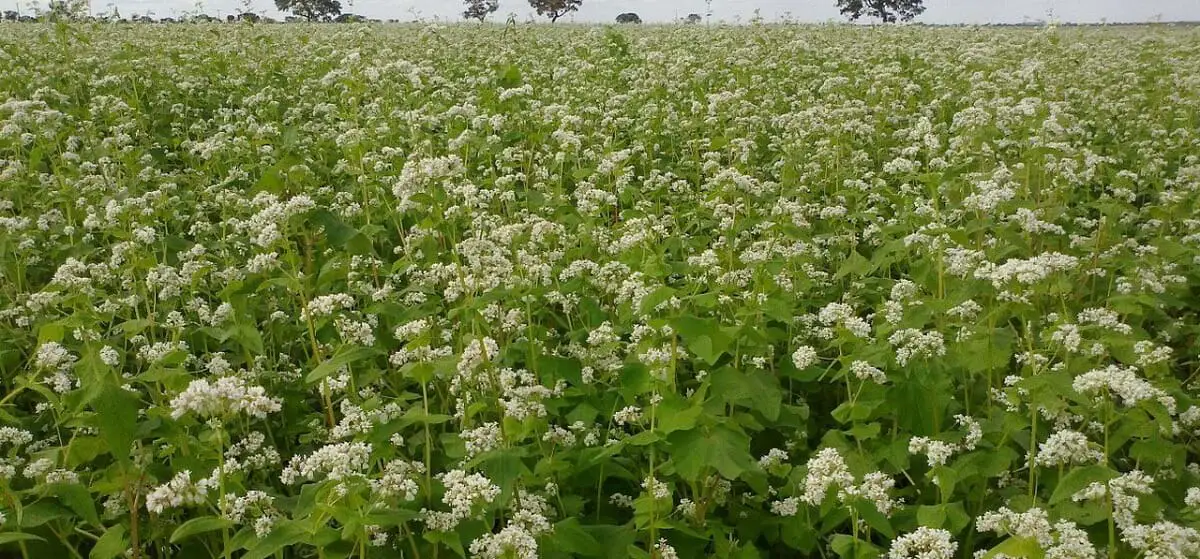Buckwheat An Astounding Green Manure How To Use For Your Amazing Garden
All About Buckwheat Green Manure

Buckwheat works excellent for producing green manure in your garden.
It is a fast-growing plant, and it makes nutritious triangular seeds. It is a short-season cover crop. It is an easy to grow annual that grows best in sandy soils.
Buckwheat grows best in a cool climate with high moisture and gets used in sustainable tropical cropping systems.
It is ready for incorporation in 35 to 40 days. However, it reaches maturity in only 70 to 90 days, and its residue breaks down quickly into the soil.
You should start adding it to your garden to attract beneficial insects, prevent weeds from moving in. It can also get used for adding bulk to your compost pile or get tilled back into your soil.
Roles of Buckwheat
- 1) Prevent weeds from moving in
- 2) Provides nectar for pollinators and beneficial insects
- 3) Improves the fertility of the soil
- 4) Provides a quick cover for your soil
- 5) It can help loosen compressed topsoil
How do you use Buckwheat as green manure?
Buckwheat as green manure
Buckwheat can get incorporated into your soil as early as 35 days after sprouting.
You must incorporate buckwheat into the soil 7 to 10 days after flowering. You have to make sure that you do not allow its seeds to set.
Once the seeds get set, there is a high chance of it becoming a weed problem if you don't go till it into your soil before the seeds get set.
Like all cover crops, buckwheat becomes green manure after you till it into your garden.
Under the right conditions, it can break down entirely into the soil in just a matter of days.
Many people confuse cover crops with green manure. But just growing buckwheat does not make use of green manure. You must flip the soil, and add the buckwheat vegetation to the ground, and decompose it, and then it becomes green manure.
How does Buckwheat improve the soil?
Buckwheat gets referred to as a phosphorus (P) scavenger since it can take up the soil (P) more efficiently than other plants.
While it is growing, the roots secrete substances that solubilize phosphorus that would not be available to other crops.
Buckwheat makes an ample amount of fine roots into the top 10 inches of your topsoil. The roots leave the topsoil loose and friable with minimal tillage and increase the water infiltration.
The fine roots make buckwheat great as a mid-summer soil conditioner before your fall crops.
Adding in the organic matter also encourages the formation of a useful microbial soil food web.
When Do You Plant Buckwheat?
It is vital to plant buckwheat early enough that you are going to avoid the first frost and late enough to avoid high heat.
In Canada and the United States, planting buckwheat in early to mid-July is usually optimal. This will allow the shorter days of August to help the seeds mature for harvesting.
Where Is Buckwheat Grown
Environmental Requirement
Buckwheat will grow in infertile and acidic soils that have a pH range of 4 to 6. It grows on various soil types but does best in well-draining soils, sandy loams, and silt loams.
It thrives in areas that are cool and moist climates but is frost-sensitive.
It does not do well in soils that are overly compacted, dry, or excessively wet.
It is common for it to wilt during the hottest part of the day and quickly recover in the damp evening air.
In Hawaii, buckwheat grows year-round at elevations ranging from sea level to 4000 ft, according to the UDSA Natural Resources Conservation Service (NRCS). The plant is not tolerant of shade.
Buckwheat Advantages and Disadvantages
Pros
- 1) Provides Quick Cover
- 2) Weed Suppressor
- 3) Phosphorus Scavenger
- 4) Thrives in Low-Fertility Soils
- 5) Quick Regrowth
- 6) Soil Conditioner
- 7) Nectar Source
- 8) Pest Management
Cons
- 1) Can Become A Weed If Allowed To Seed
- 2) Leaf Spot Caused by the fungus Ramularia
- 3) Susceptible to Rhizoctonia Root Rot
- 4) Can harbor exceptionally high numbers of root-lesion nematodes (Pratylynchus penetrans)
- 5) Susceptible to root-knot nematodes
Conclusion
Buckwheat is one of the most commonly used cover crops grown to produce green manure.
It works well to help increase soil fertility, attracts beneficial insects, suppresses weeds, has a quick growth rate, thrives in poor soils, and makes an excellent mid-summer soil conditioner.
It grows best in well-draining soils, sandy loams, and silt loams. If your soil is heavy, wet, or has high levels of limestone, it will perform relatively poorly.
It's important to remember to kill it within 7 to 10 days of flowering. If you do not kill it, it goes from being a helpful cover crop into a weed in your garden.
To make buckwheat green manure, you need to till the crop into your soil. Because of its structure, it decomposes fast, adding the nutrients it contains to the ground for your next crop.